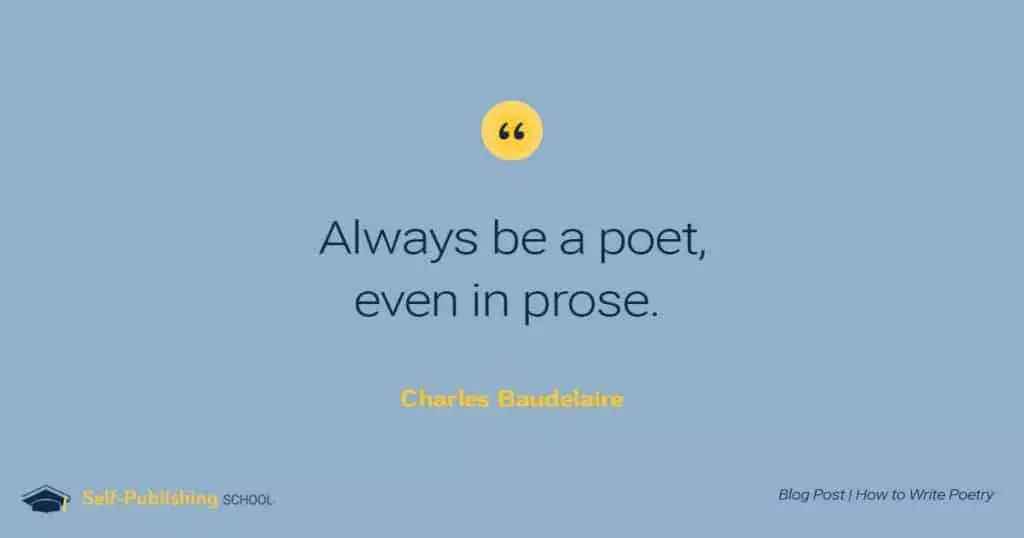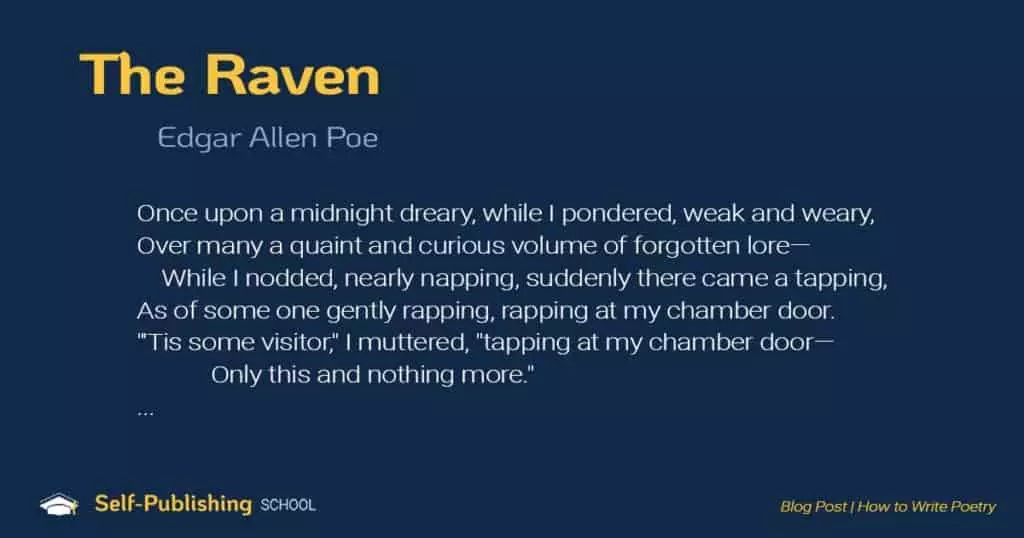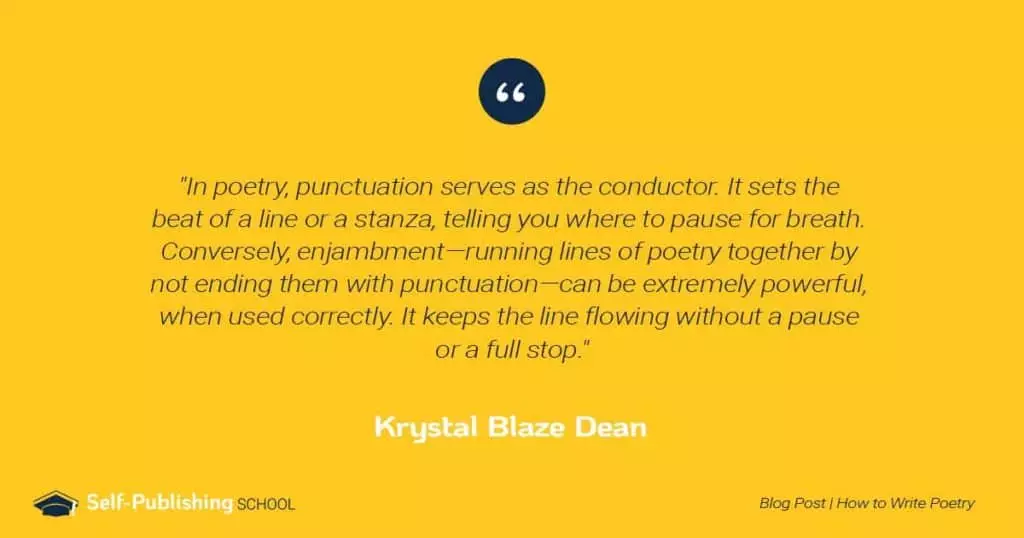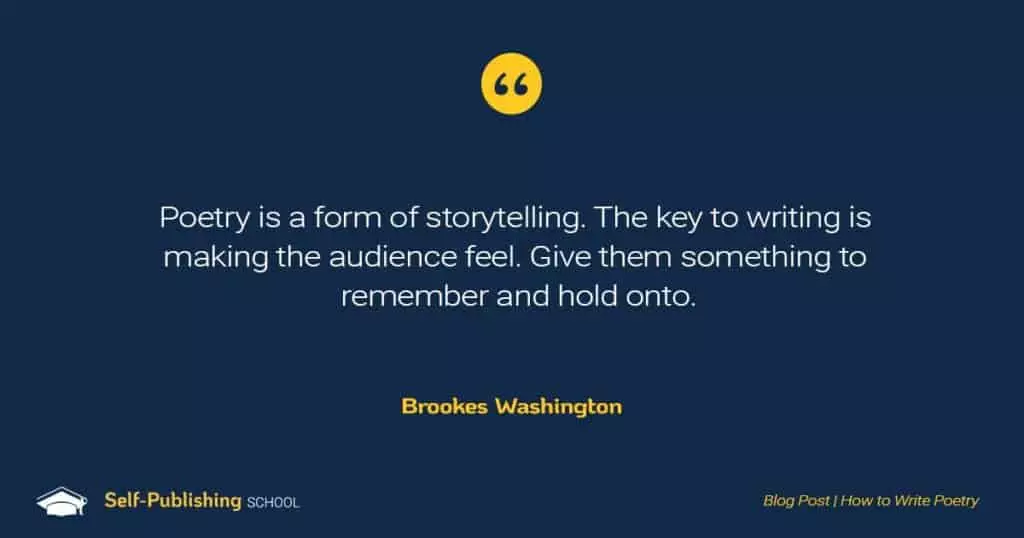Is Poetry Creative Writing
Learning how to write a poem is debatably one of the hardest forms of creative writing to master—there are so many "rules", but at the same time, no rules at all. It is the ultimate form of individual expression, yet there are creative writing prompts that fit into genres.
Confusing, right?
Despite the challenge, writing poetry is a very fulfilling creative venue, and we have exactly what you're looking for to learn how to nail this art form.
Because poetry is so specific to the artist, knowing how to write a poem in your own way can be tricky.
Here's how to write a poem using our fundamentals of poetry:
- Understand the benefits of writing poetry
- Decide which type of poetry to write
- Have proper poem structure
- Include sharp imagery
- Focus on sound in poetry
- Define the poem's meaning
- Have a goal
- Avoid clichés in your poems
- Opt for minimalistic poems
- Refine your poem to perfection
If you're ready to learn what it takes to write (and then potentially publish a book of) good poetry, we've got the help you need.
Benefits of Learning How to Write a Poem
Even if you aren't looking to become a full-time poet, or even attempt to publish a single poem, writing poetry can be beneficial in several ways.
- It strengthens your skills in writing solid imagery. Poetry is a very image-based form of writing, so practicing poetry will improve your imagery in other forms as well.
- Poetry is concise and impactful—it uses strong language, and no more words than are necessary. If you have an understanding of how to write a poem, your prose when writing a novel will become crisper and stronger.
- Poetry helps you to connect with emotions in a tangible way. Other forms of writing have the plot to hide behind—with poetry, all you've got are emotions. (Unless it's a narrative poem, of course.)
- You can become a professional poet and earn a living writing. Even if you just want to enjoy poetry for the above reasons, you can also make a full-time income this way. A great way to get started is to apply for a poetry scholarship in addition to the rest of the tips here.

Types of Poetry
Not all types of poetry are the same, and that means learning how to write a poem involves being familiar with the different types.
Here are the different types of poetry:
- Narrative – this kind of poem relies on a story. It tells an event and there are often a few extra elements, such as characters, a plot, and a strong narration.
- Lyrical – a lyric poem is similar to a song, and it tends to describe a specific feeling, scene, or state of mind.
You may be familiar with these different types of poetry. For example, a lyrical poem is actually a song. Listening to your favorite radio station is just like hearing a collection of your favorite poems being read to you with some background music.
A narrative poem is, as mentioned above, more like a story told in poetic prose.
Here's a small example of a part of Edgar Allen Poe's famous poem, The Raven:

8 Fundamentals for How to Write a Poem
Poetry can often be subjective. Not every poem will speak to every person.
That being said, there are different attributes that you should learn if you want to know how to write poetry well regardless.
#1 – Structure of writing a poem
The structure of a poem can refer to many different things, but we're going to discuss some different forms of poetry, how to use punctuation, and last words.
Form of a Poem
The form of your poem is the physical structure. It can have requirements for rhyme, line length, number of lines/stanzas, etc.
Here are different types of poetry forms:
- Sonnet – A short, rhyming poem of 14 lines
- Haiku – A poem of 3 lines where the first is 5 syllables, the middle is 7 syllables, and the last is 5.
- Acrostic – A poem where the first letter of each line spells a word that fits with the theme of the poem or exposes a deeper meaning.
- Limerick – This is a 5-live witty poem with the first, second, and fifth lines rhyme as do the other two with each other.
- Epic – This type of poetry is a lengthy narrative poem celebrating adventures or accomplishments of heroes.
- Couplet – This can be a part of a poem or stand alone as a poem of two lines that rhyme.
- Free verse – This type of poem doesn't follow any rules and is free written poetry by the author.
The majority of poets, specifically less experienced ones, write what's called free verse, which is a poem without a form, or with a form the poet has made up for that specific piece.
A poet may decide to have a certain rhyme scheme or might make their poems syllabic.
With a free verse poem, you can set up any theme or pattern you wish, or have none at all.
The great thing about poetry is that you can even start with a specific poem form, and then choose to alter it in order to make it unique and your own.
Poetry Punctuation
Writing a poem is difficult because you never know what the appropriate punctuation is, because it can be different from punctuation when writing a book.
There are essentially three ways to punctuate your poetry:
- Grammatically – this means you use punctuation properly for every grammar rule; if you removed the lines and stanzas, it would work as a grammatically correct paragraph, and this even includes writing dialogue in your poem.
- Stylistically – this means you use punctuation to serve the way you would like the poem to be read. A comma indicates a short pause, a period indicates a longer pause, a dash indicates a pause with a connection of thoughts. Using no punctuation at all would lend to a rushed feeling, which you may want. Your punctuation choices will depend on your goals when writing a poem.
- A combination. Maybe you want to mostly follow punctuation rules, but you have a certain line you want read a certain way. It's totally fine to deviate from standard rules if it serves a purpose—you just need to do whatever you're doing intentionally. Know the rules before you can break them.
"In poetry, punctuation serves as the conductor. It sets the beat of a line or a stanza, telling you where to pause for breath. Conversely, enjambment —running lines of poetry together by not ending them with punctuation—can be extremely powerful, when used correctly. It keeps the line flowing without a pause or a full stop." – Krystal Blaze Dean

Last words of a poem
The last word of a line, the last word of your poem, and the last line of your poem are very important—these are the bits that echo in your reader's head and have the most emphasis.
Ending with punctuation (dash, period, comma) versus ending without punctuation will give you a dramatically different read, so consider the effect you'd like to have.
Tip for last words : read the poem out loud a few times to see where you'd like the inflection and emphasis to fall.
#2 – Imagery
Imagery is a literary device that's a tangible description that appeals to one of the five senses.
The more imagery in a poem, the more the reader can connect with it.
Tip for imagery : focus on details. Instead of going for the obvious description, really put yourself in that moment or feeling—what details are the most impactful and real?
Here are some examples of imagery:
- Pungent fumes lifted from the floor beneath her.
- Burning light painted the insides of his eyelids red.
- Hair from her ponytail bit at her face, swept into a frenzy by the furious winds.
- Crackling popped in rhythm to the dancing flames.
#3 – Sound
While imagery is for the mind, sound is for the ear. How do your words and lines sound when read out loud?
The most basic sound style is a rhyme, however, you should never force a rhyme!
If you try for exact rhymes on every line, it becomes "sing songy," and this is a big, red mark of an amateur. Sticking to a strict rhyme scheme can severely limit your word choice and creativity.
Instead of going for exact end rhymes, here are some options to achieve that appealing auditory effect of rhyming when writing poems:
- Assonance – the repetition of a vowel sound in non-rhyming, stressed syllables. Assonance gives you the fun sound effect of a rhyme without sounding campy. An example of assonance is: "Hear the mellow wedding bells" by Edgar Allen Poe.
- Alliteration – the repetition of a consonant at the beginning of words. Specifically hard consonant sounds like T, ST, and CH have a hard, staccato effect that a lot of poets like to use.
- Internal rhymes – words inside of lines rhyme, rather than the end words. Like assonance, you get the effect of a rhyme without sound like a Dr. Seuss ripoff.
Tip for sound in poetry : Focus on beautiful, crisp imagery to carry your poem, rather than strictly relying on the sound and structure of it.
#4 – Meaning
Structure, imagery, and sound work together to make up the technical excellence of a poem. But if your words are empty of a deeper meaning, what's the point in writing a poem at all?
"Poetry is a form of storytelling. The key to writing is making the audience feel . Give them something to remember and hold onto." – Brookes Washington

Many new writers latch onto clichés and tired topics (peep that alliteration) for their poems, because they think that's what they're supposed to do.
But emulating something someone else has done, or some idea of what you should think a poem should be about, isn't going to give you a genuine, emotional piece that other people can connect to.
So write the poem that only you can write.
Tips for how to write a poem with meaning:
- Brainstorm poetry topics by looking at your own experiences. What do you know? When is a time you felt very deeply about something? Can you put that feeling into words? Can you make that feeling an image other people can see through your words? That is the poem you write.
- You don't need some grand, dramatic emotion to write about—think about the ordinary things that make us all human.
"Nothing ever ends poetically. It ends and we turn it into poetry. All that blood was never once beautiful. It was just red." – Kait Rokowski
#5 – Have a goal
Have a goal with writing a poem—what do you want your audience to feel?
Are you just writing for fun or for yourself? Poetry is often a very personal form of writing, but that doesn't mean you shouldn't think about your audience at the same time.
If you want to publish your poetry eventually, there are a few things to think about in terms of your goals.
What emotion or moral do you want to convey? What are you trying to express?
These are important questions to answer in order to write an impactful and memorable poem.
#6 – Avoid cliche phrases when writing poetry
There are many clichés you want to avoid when writing poetry.
Nothing really marks an amateur poet like clichés (and forced rhymes, like we mentioned before).
Despite the temptation, avoid cliché phrases. Go line by line and make your language as crisp and original as you can.
If there are pieces in your poem that seem like you've read or heard them before, try to reword it in order to make it more original.
#7 – Opt for minimalism
Err on the side of minimalism. Once you have a draft, cut it back to the bare, raw necessaries.
Every word should be heavy with emotion and meaning, and every word should be absolutely essential.
If your poem seems long-winded to you, imagine what that would be like for your reader. Be ready to edit your poem to get it down to its best form.
"Poetry is just word math. Every piece has mean something , and there can't be any extraneous bits otherwise it gets confusing. It just becomes a puzzle made out of all the words that make you feel something." – Abigail Giroir
#8 – Refine your poem
The real magic of poetry happens in the revising and refining.
Revise the ever-living heck out of it. To paraphrase an old professor of mine: Don't be afraid to sit with it. For weeks, months, years—as long as the poem needs.
It's great to have writing goals and timelines, but don't rush a poem before you know it's ready.
Avoid abstractions. An abstraction is a word that can only refer to a concept or feeling—it's not a concrete, tangible thing. Some examples of this are liberty, love, bondage, aggression.
Abstractions make every person picture something different, so they are weak words, and they will weaken your poem.
Instead of using an abstraction, think of what imagery you can use to convey that emotion or concept. Liberty can become chains breaking or birds flying. Love can be bringing your spouse coffee in bed, petting a dog, cleaning a gravestone.
Think of the best images to convey your idea of that abstraction, so every reader can be on the same page with you.
Don't pigeonhole yourself into a form that will stifle your creativity, utilize imagery and sound, have a meaning and a purpose for every poem, and revise until your fingers bleed.
Disclosure: Some of the links above may contain affiliate partnerships, meaning, at no additional cost to you, Self-Publishing School may earn a commission if you click through to make a purchase.
Source: https://self-publishingschool.com/how-to-write-a-poem/
0 Response to "Is Poetry Creative Writing"
Post a Comment